Reading Room Search
Go here for complete Reading Room Article Index
Displaying 251 - 275 of 607Media Literacy Day '99 Spotlights Successful Skills for Teaching
-- Actors challenge teachers to pull curtain on media 'constructions.' -- 'Visionary' Award honors TV pioneer for commitment to media education
Put 100 teachers in a room for a day to hear thoughtful speakers, attend workshops with practical ideas for the classroom, examine resource tables full of books and videos and lesson plans, network over coffee and muffins and a box lunch with colleagues from Santa Barbara to San Diego and what do you get?
The first annual Media Literacy Day in L.A.!
Held Saturday, October 30, the event, organized by the Center for Media Literacy, featured over 20 in-service presentations by Hollywood media professionals and teacher-... Read More
20 Ways to Create a Caring Culture - Part II
Action Ideas for Children, Families, and Groups By Jay Dover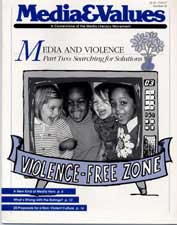
< < Read Part I: Introduction
Nonviolent Computer Game
Using CD-ROM technology, a computer game along the lines of Carmen Sandiego would challenge players to solve conflicts nonviolently. Anger management and conflict resolution skills could be employed as modes of action. The game would be equally effective as entertainment in the home and an educational tool in schools. Design and format could be developed for different age groups.
... Read More
Parents can...
...read storybooks that help their young children understand that TV is not a magic box for passive entertainment, it's just one of a child's many "things to do." ...read and explore this website for information to help their family better manage their "media diet," and to use TV and computers to increase, rather than decrease, communication. ...talk to their children's teachers and school administrators about the importance of media literacy, and provide materials, catalogs and information for the school's follow-up. ...talk to their local public librarians about acquiring... Read More

April, 1998: Over 1100 teachers and administrators participated in a first-ever media literacy "mini-conference" held as an integral part of the annual convention of the National Catholic Educational Association (NCEA) at the Los Angeles convention center, April 14-17. Participants represented more than 200 Catholic schools and parishes around the U.S. including 90 in Southern California.
The mini-conference was organized by the LA-based Center for Media Literacy, a national non-profit organization, in collaboration with the NCEA, the Center for Religious Communications at the University of... Read More
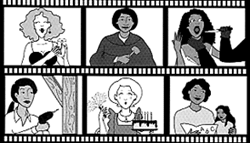
When Women in Film, an organization of industry women in Los Angeles, instituted The Luminas Awards for the positive depiction of women in media, they spent much time developing and clarifying the criteria for the awards.
Do you agree with the following guidelines?
Is anything left out from your point of view?
Tape your favorite television show and then replay it in class or with a group of friends.
Discuss each of the women characters in turn, using the seven criteria adopted by Women in Film.
Make a copy of the criteria (including any criteria you want to add to the list) on a card... Read More
Strategic Alliance Links CML To Major U.S. Educational Distributor
Great Plains National to collaborate on standards, e-commerce to serve growing media literacy marketplace. October 1, 2001 - A new era for the media literacy educational movement in the US begins this fall with the announcement today of a strategic marketing alliance between the Los Angeles-based Center for Media Literacy (CML), known for its comprehensive clearinghouse of PreK-12 teaching resources for media education, and Great Plains National (GPN), one of the country's largest educational product distributors located at the Nebraska Educational Telecommunications & University of Nebraska in Lincoln.
The alliance is designed to respond to the growing demand for media literacy... Read More

At the beginning of the 20th Century, about the time the movies were invented, our visions of the future were transformed from utopian dreams into urban nightmares.
Many factors were at work. But it's likely that the new visual media played an important role in this shift. Film and later television producers found it easier to visualize a world of surrealistic decay than to laboriously shape entertainment that, as Gloria de Gaetano, media literacy author from Redmond, Washington, puts it, "shows people negotiating conflict and resolving it through communication, understanding and empathy."
It... Read More
CML Seals Alliance with Distributor of Classroom Resources
Teacher's Discovery, Inc. to collaborate on new product development, conferences to serve growing media literacy marketplace. November 12, 2001 - A sign of the growth in the media literacy educational movement in the U.S. is the new strategic marketing alliance announced between the Los Angeles-based Center for Media Literacy (CML), known for its comprehensive clearinghouse of PreK-12 teaching resources for media education, and Teacher's Discovery, a leading producer, creator, and distributor of educational materials headquartered in Auburn Hills, MI.
"The combination of education reform and cataclysmic national events have propelled media education forward as teachers strive to help students gain critical... Read More

Stories of violence are familiar to anyone with a television in America today. Whether flashed on the nightly news, dramatized in a sensational movie of the week or packed into "action" blockbuster films (a guy, a gun and an attitude!), not a day goes by that we don't get a dose of aggression from the media. And it's getting worse.
Recent cover articles in Time and Newsweek have detailed the rising wave of violence holding society... Read More

I'm riding on a subway in New York City when I see a ballet-like hand weave between the packed-in crowd and slip into a pocket. What you did isn't right," I find myself declaring to the young man connected to the hand. "What?" he shouts, drawing back emptyhanded. "I'll cut you. I'll dice you."
The entire subway car falls silent. You could hear a pin drop. I'm looking him dead in the eye. He's looking at me. The subway door opens. He turns and walks off mumbling and cursing. The entire subway car... Read More

The television violence overkill was first reported in a study by the National Association of Educational Broadcasters in 1951. The first Congressional hearings were held by Senator Estes Kefauver's Subcommittee on Juvenile Delinquency in 1954. The usual industry suspects were rounded up and gave what have since become the usual promises of mending their ways "next fall."
Next fall and most subsequent seasons, violence further increased as the freeze on new TV frequency allocations established the unchallenged cultural hegemony of national network broadcasting.
What is... Read More
Educational Standards and Media Literacy
Integrating Media Literacy Across the Curriculum A CML Reflection Resource
Integrating Media Literacy Across the Curriculum
Media literacy is most successful when it is integrated across the curriculum and, thus, related to national, state or district educational standards and assessment rubrics. CML's experience with Project SMARTArt demonstrated that, given training and practice through professional development, teachers can easily integrate curricula, devising lessons that incorporate CML's media literacy framework while meeting state education standards in at least three subjects in as little as 20 minutes.
CML's framework for media literacy serves as an... Read More

The author reflects on how students learn in today’s “digital swarm” and proposes four ways for teachers and schools to engage young people in the classroom. “Any child can operate the devices that transmit the media; the imperative is to provide our youth with the proficiencies to operate them with responsibility, insight and judgment.”
To access the full article, click here.
This article originally appeared a special Symposium Issue on Media Literacy and Arts Education, in Arts Education Policy Review, Vol. 102, No. 6; p. 25-27, July/August, 2001. Reused with permission of the... Read More
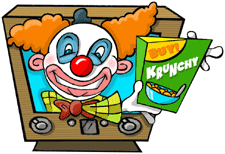
A mother reflects on how "commercial media teaches our children to settle for the pose. . .Our challenge as parents and educators is to lead children beyond the shallow poses sold by the media to the processes of a truly engaged life. It is, after all, the capacity to think deeply and independently that will lead to true accomplishment and the clearest expression of who they really are."
To access the full text of this thoughtful article, click here.
This article originally appeared in a special Symposium Issue on Media Literacy and Arts Education,in Arts Education Policy Review, Vol... Read More
Community/Schools Partnership for the Arts: Collaboration, Politics, and Policy (Arts Education Policy Review)
454_Stankiewicz_ja01.pdf

"In this technological, secular society, we find in television our deepest rituals, rituals that tell us who we are, where we came from and where we're going," believes Dr. Gregor Goethals, professor of art history at Rhode Island School of Design.
Suggesting that popular culture uses ritualistic models, Goethals, speaking recently to the "Friends of Media&Values" in Los Angeles, found two television staples that use evangelical traditions: nightly news programs and Presidential press conferences.
"Presidential press conferences take place in a very special place and time," Goethals said... Read More

Concerns about media violence shared around the world have spurred regulatory efforts in many other countries. According to a recent MediaScope study (Film and Television Ratings: An International Assessment, 1993), comparing rating systems in 36 countries and provinces, there has been more action taken elsewhere to curb the effects of violence than in the United States. For example, the British Board of Film Classification has required that many violent scenes be cut from the American versions of popular films (including the Rambo, Die Hard and Lethal Weapon series, even Teenage Mutant... Read More

My grandmother, who raised five children in a small Virginia mountain town as a storekeeper's wife, who chopped chickens' heads off with skill and plucked them pretty clean, made the papers only when she died. Nobody thought to ask her about the changes she had seen in rural America. My mother, who grew up crossing New River on a small ferry boat to go to school, who became the first in her family to finish college, and who was fired from her teaching job because she got married, carries in her mind a first-person view of Depression-era Washington, where she worked for the Rural... Read More
Worlds Apart: Women, Men and Technology
An exploration of the impact on women of the male technological world view. By Margaret Brenston
By my early teens, while boys my age were discovering cars and pinball machines, I discovered books and horses. Later in adolescence, Friday night at the local drive-in would be spent with boys discussing cars or football and the girls discussing clothes or gossiping about friends. In high school, shop was required for boys and home economics for girls, but even if any of the girls had had a choice, we would never have ventured into the world of tools and grease.
Unlike most of the girls I knew, however, I liked science in high school and majored in chemistry in college. I was odd enough to... Read More
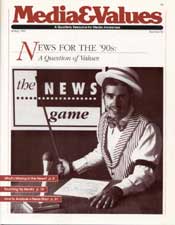
One of the most dramatic changes in television reporting has to do with the way statements by the president and other top administration officials are handled. Until the early ‘70s, it was common for the White House correspondent to simply introduce a presidential statement with a brief summary and then to run the president's remarks unedited, often for two minutes or more.
Today TV reporters routinely cut an official's remarks into 10- or even 7-second sound bites, then weave these into their own narratiion. It is the journalist, not the official, who speaks to the news audience... Read More
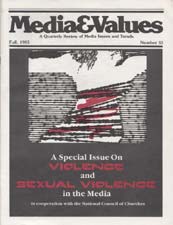
Researchers are studying the fusion of aggression and eroticism in film and video. They're asking whether it's creating a climate in which sexual violence is more acceptable in real life.
For centuries, society has been concerned about the depiction of sex and sexuality in its popular media. Pornography has been banned and booed and society's standards of what is and is not acceptable have continually evolved.
In more recent years there has been an added concern about the growing problem of media violence, especially after television's home screen began to show scenes of murder and mayhem... Read More

For many youth there are no rites of passage that confirm their arrival at adulthood, except for the driver's license, the permission to purchase alcohol, and the right to see R-rated films. Confirmation even appears to be greater when these rites can be combined. Because of this situation, many young people limit their film patronage to only R's and X's until the point is made – much the same way that adults frequent various clubs to signify their financial or social arrival.
Ironically, for many young people, the film rating system is far from helpful to their welfare. The pressure is on... Read More

News has always mixed the serious and the entertaining. The tension between journalism and commercialism goes back long before television, but it is felt with special intensity in television news today.
In the early 1960s the networks, hugely profitable but worried about their images and about regulatory pressures, expanded their news operations and largely freed them from the pressures of commercial television. The "church" of news was to be separated from the "state" of entertainment.
In the 1970s and '80s, however, the barrier between news and entertainment has been increasingly eroded.... Read More
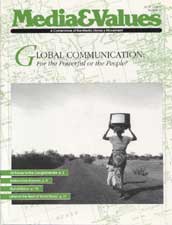
Storytelling is the great process that makes us recognizably human. A story is an attempt to make the invisible visible — it has to do with relationships, with intellectual connections. We have to have some device to make the visible, dramatic, revealing and embodied in human beings whose characteristics we know and whose actions we can understand. We live our lives in terms of the stories we tell.
What are these stories? How do we weave them into the very complicated uniquely human structure called culture? Basically there are three kinds of stories:
There are stories essentially... Read More
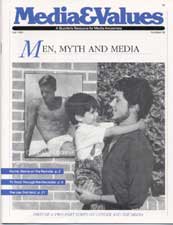
"What is a man?"
This may seem like an odd question to be asking, but it's one that's answered all the time in print ads and television commercials. Ads and commercials, with their images of cowboys, successful businessmen, construction workers, sophisticates in tuxedos, muscle men and others, advertisements may seem to be flashing by casually. But they actually represent countless – if often unconscious– decisions by writers, advertisers, producers, programmers and others about what men look like, say and even think.
As each ad answers the questions: "What images of men will sell my product... Read More

